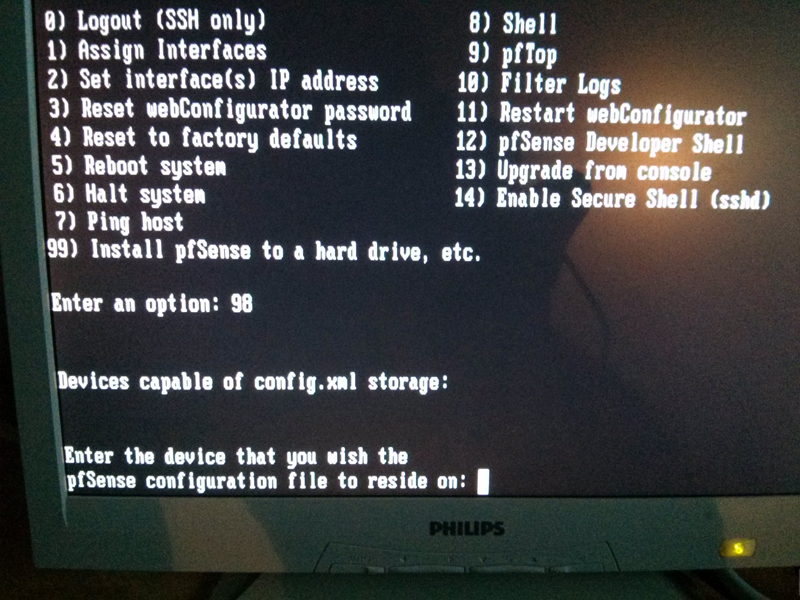[running from USB] unable to store config
-
hello everyone,
i'm trying to run pfSense from a USB keydrive (the system lacks both optical and HDD drives). ofc i'd like the system to return to normal operation after e.g. a power failure (or something tripping over some cable, whatever) which -from what i understand- requires it to store its config file somewhere…be it on the same(?) or a second(?) usb drive. if i run option "98" however, i get the following message:

i tried entering "0", "1" as well as "da1" to no avail. it states SOME sort of success by saying "done" tho. still, the 2nd pen drive stays empty and the first one (the one i'm running pfsense from) wont hold the cfg either.
any help is greatly appreciated :)
-
bump…i'm sure i'm just getting something wrong or trying to do something that pfsense isn't capable of.
-
Why not install pfSense to one of your USB sticks and run it in the more conventional way?
You might be better off using the nanoBSD based version of pfSense: Download an image suitable for the size of the SB stick you have, write the image to the stick and boot.
If you want to save your current config (so you don't have to go through the configuration process again) you should be able to do that through the pfSense web interface.
-
Why not install pfSense to one of your USB sticks and run it in the more conventional way?
You might be better off using the nanoBSD based version of pfSense: Download an image suitable for the size of the SB stick you have, write the image to the stick and boot.
If you want to save your current config (so you don't have to go through the configuration process again) you should be able to do that through the pfSense web interface.
well, i thought the "install" option was intended EXCLUSIVELY for internal drives - i tried to run it once -> it threw an error at me -> i gave up ;)
i will of course do it like that since -as you stated- it seems to be the traditional way.
@saving the config: i assume an installed version on my USB drive will automatically store its config on the drive itself, right? my only concern was having to re-configure everything after a power outage…i dont need a backup of the config at hand.
will take a look at the nanoBSD-version as well.
thanks a lot, think i got it from here :)
-
The memstick is really just the LiveCD - it's still treated like a read-only medium so it won't save its config to the stick itself. Eventually that situation could be improved/changed, we just haven't had much demand to do so yet.
-
thanks again - got it running now (the install giving errors in the firstplace was solved by using a really 'clean' usb drive)
just one more quick question: may i simply ignore "interrupt storm" errors or are they concerning at all?
-
It depends on the interrupt that's having the issue.
If it's a NIC or storage medium, then it should be looked at.
If it's something you don't use, like a parallel port, then it can be ignored.
Check dmesg and "vmstat -i" to see what devices are on each irq.
-
It depends on the interrupt that's having the issue.
If it's a NIC or storage medium, then it should be looked at.
vmstat told me it's "mskc0", i then ctrl-f'd (no pun intended) the status.php to get the lines below…msk0 being my WAN network adapter, so yeah, it seems like something important. irq10 is shared between mskc0 und uhci2, the latter seems to be the USB controller itself (if that makes sense).
is there a quick workaround/way to re-assign interrupts? i already disabled as much unneeded hardware in BIOS as possible (even before my first installation attempt of cource)
May 8 16:36:15 pfSense kernel: mskc0: <marvell yukon="" 88e8056="" gigabit="" ethernet=""> port 0xbe00-0xbeff mem 0xfdcfc000-0xfdcfffff irq 10 at device 0.0 on pci3 May 8 16:36:15 pfSense kernel: msk0: <marvell technology="" group="" ltd.="" yukon="" ec="" ultra="" id="" 0xb4="" rev="" 0x02=""> on mskc0</marvell></marvell>AND
May 8 16:36:15 pfSense kernel: uhci2: <intel 82801g="" (ich7)="" usb="" controller="" usb-c=""> port 0xfc00-0xfc1f irq 10 at device 29.2 on pci0</intel>/edit: i've been solo-testing this system since yesterday, streamed video, downloaded stuff and even played diablo without any signs of lag. it's intented use is providing internet (for websurfing only, line is 6mbit max.) in 2 vacation apartments, so nothing fancy here - could my IRQ-problem cause any bad stuff except for occasional slowdowns? because i wouldn't care too much then.
ty in advance.
-
Mostly it would lower the potential throughput, but it could cause other general flakiness.
There are usually some BIOS options to tweak about PCI IRQs, PnP OS, or similar. Some BIOS have an IRQ table config to hardwire them or reset any automatic mapping.
If there are multiple USB controllers, disabling one or more may help, or just moving the USB disk to another port may even help.
-
thanks, will try. although the BIOS didnt offer that many options iirc.
will report back later, today is a traditional german drinking day, so yeah brb :)
-
final post - solved the interrupt storm issue by enabling APIC in bios - one of the few options the board gave me.
everything is up and running now, thank you again for your effort :)